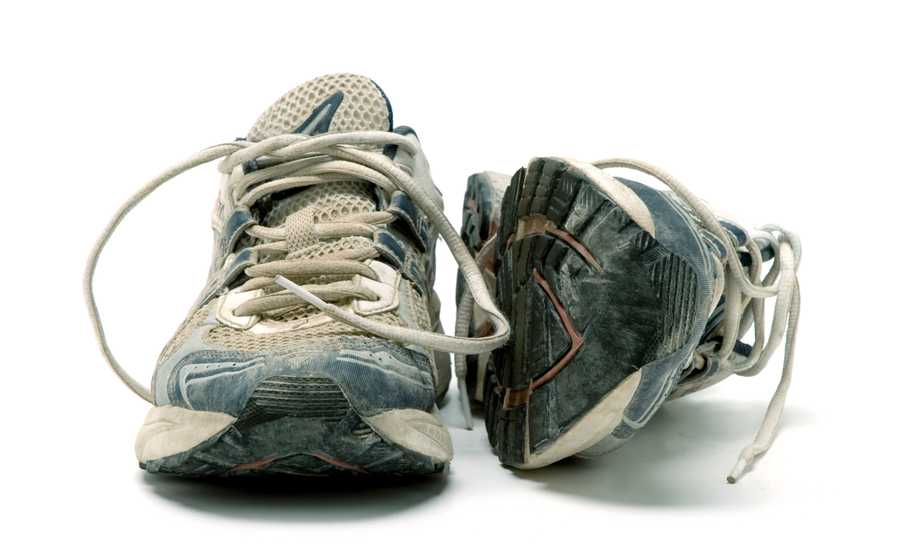When to Replace Running Shoes

Our evaluations and opinions are not influenced by our advertising relationships, but we may earn a commission from our partners’ links. This content is created by TIME Stamped, under TIME’s direction and produced in accordance with TIME’s editorial guidelines and overseen by TIME’s editorial staff. Learn more about it.
Whether you’re a regular runner or a casual athlete, a good pair of running shoes can be a precious commodity. After the first few wears, the shoe will break in and conform to your specific fit, creating a superior feel and more comfortable experience. The problem is you can’t keep your running shoes in this condition forever. Over time, the components will continue to break down and degrade, until the shoe no longer performs as needed. This doesn’t just lead to worse running performances, but also to long-term harm.
“Old shoes may feel familiar but the reality is that the cushion degrades, the support breaks down, and you become more prone to injuries,” said Steve Lemig, communications director at Road Runner Sports. “When your shoe’s cushion is compressed, the impact of every step increases and puts extra stress on your joints, muscles, and tendons.”
Even your beloved sneakers will need to be replaced eventually. Here’s how to know when the time has come, why it’s important to change them out, and what you can do to extend the life of your favorite pair.
The motion of running means the soles of your shoes repeatedly hit against the ground. “Shoes break down mostly from repeated impact from running and walking,” said Lemig. “Each step a runner takes produces a force that’s three to four times your bodyweight.” Over time, this pressure and friction can wear away at the material of the outsole. This damages the tread, which affects your grip and stability, especially on wet surfaces. Worn-out soles are an easy giveaway that your running shoes are past their prime and could need replacing.
This wear and tear can also be exacerbated if your feet naturally curve inward or outward. Uneven weight distribution will lead to uneven wearing of the soles, which should be easy to spot. “Replace [your running shoes] when your sneaker soles have uneven wear due to pronation (more weight on the inside of your feet) or supination (more weight on the outside of your feet),” said Susannah Davda, director at The Shoe Consultant. “When you wear old sneakers which have worn unevenly on the soles, your feet are not properly supported”
“Neglecting to change your sneakers can lead to chronic foot pain and more severe issues like joint pain, back pain, and even injuries that require medical intervention,” warned Gregory Alvarez, DPM, FACFAS at Ankle & Foot Centers of America. If your shoe fits correctly but still causes discomfort after wear, then this could mean your running shoes are no longer providing the level of support you need.
Don’t confuse lack of structure with other causes of pain, such as too tight shoes or blisters — those problems can occur even with brand-new shoes. However, if you notice over time your feet are particularly tired or aching after wearing your favorite sneakers, especially if they used to feel supportive, then this could be a sign that the interior components are degrading.
A large part of running shoe degradation occurs in the midsole, which isn’t visible to the naked eye. However, you will definitely feel the impact underfoot as this correlates with a loss of cushioning. Decreased cushioning isn’t just about comfort either. The midsole is also responsible for shock absorption, so as it degrades, your feet and joints will suffer more from the impact of running.
Older running shoes tend to fall apart, especially if they’ve been used consistently for high-intensity exercise. Common signs could be fraying seams, loose uppers, or even broken down lining at the heel, which exposes the hard heel stiffener. While these won’t necessarily impact the shoe’s performance, they could be a sign there's worse damage internally.
Running shoes are designed to maintain the integrity of your gait and support as you run on various surfaces, for varying distances. Once they’re no longer able to fulfill this purpose, they could actually do real harm to your body. It’s not just about not being able to run at your best level—it’s about ensuring you’re able to run at all in the future.
“Your feet are the foundation of your body, and wearing inadequate footwear compromises that foundation, affecting your overall posture and biomechanics,” said Dr. Alvarez. “As sneakers degrade, they lose their cushioning, support, and shock absorption capabilities. This can result in increased stress on your feet, ankles, and even your knees and hips. Over time, this stress can lead to conditions like plantar fasciitis, tendinitis, and stress fractures.”
For suggestions on new shoes, read our guides on running shoes for women and running shoes for men.
The lifespan of a pair of running shoes varies depending on the quality of the shoes and the level of exercise for which you use them. High-intensity activities, such as distance running on concrete or basketball, will put more strain on the shoe than a casual walk. Frequency is also important. If you’re running every day, your shoes will break down quicker than if you run once per week.
Then, there’s the make of the shoe. Sneakers that are constructed from high-quality materials may also have performance-enhancing attributes that help the shoe to withstand impact, lengthening their lifespan. Lastly, higher body weights exert more pressure on the shoe than lower body weights, leading to faster degradation of the footwear.
There is a general rule of thumb that you can follow to get a sense of how long your new shoes will last. “Mileage is a big factor in how often you need to replace your shoes,” said Lemig. “At Road Runner Sports, we typically recommend replacing your shoes after 300 or 350 miles of use. Higher quality shoes can last longer.”
“To extend the life of your sneakers, consider rotating between multiple pairs to allow each pair to rest and decompress,” recommended Dr. Alvarez. Since frequency of use is a big factor in how quickly your shoes will break down, make your running shoes last longer by having several pairs that you rotate. If you regularly switch use of three pairs of shoes, then you’ll use each one a third as much as you otherwise would. This also allows each pair to fully dry out after sweaty exercise, inhibiting the growth of bacteria which can also limit the lifespan of your shoes.
“Save your running shoes for running,” said Lemig. “Every step you take in your shoes wears them out that much quicker.” If you have a favorite pair of high-performance running shoes, try not to wear them for other activities where non-performance footwear will suffice. This will ensure you’re getting the best from your running shoes. Consider having a secondary pair of sneakers for more casual activities.
Running shoes degrade over time just from repeated wear, but this process speeds up if you don’t take proper care of your shoes. Direct sunlight and extreme temperatures will damage the shoe’s materials, so be sure to store your footwear appropriately. Make sure to wash off any dirt or grime after use, wash your shoes every month or so, and be sure to let shoes dry thoroughly. Packing them with newspaper is a good way to do that.
“Allowing moisture to fully evaporate before the next wear can prevent odor,” said Davda. “If you have leather sneakers, polishing them regularly keeps the uppers supple and stops them from drying out and cracking.”
The information presented here is created by TIME Stamped and overseen by TIME editorial staff. To learn more, see our About Us page.



